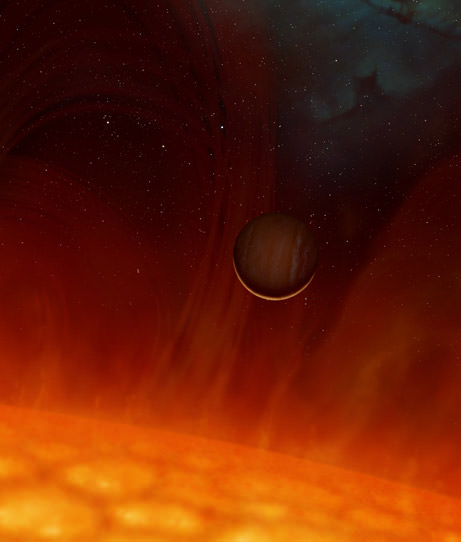[/caption]
Some interesting new additions to the exoplanet family were announced last week by astronomers from Penn State University. While finding exoplanets these days may be considered “just another day at the office,” astronomers discovered three unique planets and an additional “mystery” object. What’s unique about these planets is the fact that the stars they orbit are all old and dying – red giant stars which have swollen up as they near the end of their lives, which ordinarily would consume any unlucky planets which may be too close to escape…
The three stars are HD 240237, BD +48 738, and HD 96127; the second one also has the mystery object orbiting it, which may be another planet, a low-mass star or a brown dwarf — something whose mass is in between that of a smaller, cooler star and a giant planet.
“We will continue to watch this strange object and, in a few more years, we hope to be able to reveal its identity,” said team leader, Alex Wolszczan.
Wolszczan was the first astronomer to discover exoplanets, three small planets orbiting a pulsar (neutron star) in 1992.
It is expected that our own Sun will also become a red giant star in another five billion years or so. Not a good thing for us obviously, but still a long ways off thankfully, since at that time, all of the inner planets of the solar system will probably be consumed by the expanding Sun.
The subject of planets orbiting dying stars will also be the focus of an upcoming conference, Planets Around Stellar Remnants, in Puerto Rico next January. It is organized by Penn State’s Center for Exoplanets and Habitable Worlds, and will take place exactly 20 years since Wolszczan made his discovery.
Interesting, since by far most of the exoplanets found so far orbit “normal” stars, like our Sun, which are still in mid-life or younger. But now, they’ve been observed around stars at all different stages of evolution, from the youngest stars, even those still with protoplanetary disks, to the oldest, stars which have already died and burned out, like pulsars. What this seems to indicate is that planets are a normal part of star formation, from beginning to end. The numbers now being found by astronomers, in the thousands and likely millions or billions, also suggest this; a big change from just a few decades ago when it was unknown if there were any other solar systems out there at all. There are, a lot of them.
Source: Penn State University


Very unique? Seriously?
It’s either unique or it isn’t.
One is tempted to ask: how can any of them be unique if there are three of them? 😉
Now that would have been a better way to point out the error. Nobody likes a pedant who takes themselves seriously.
its a lost death star!
~ 20 years after the first exoplanets are discovered (1992; or 1988 if Gamma Cephei original discovery is used), we now have predictivity as people expected this:
“But now, they’ve been observed around stars at all different stages of evolution,”
Forget the baby steps, now we are running!
It is believed that the biosphere go extinct long before that though. Every aging star increases its output.
The change was a problem when the Sun was young since at ~ 4 Ga bp [billion years before present] Earth received a mere ~ 70 % of todays irradiation. Only our greenhouse atmosphere, probably more CO2,* kept water above freezing then.
And it does that still, at a lower level. Luckily CO2 is removed by dead animals in oceans (mostly) in the form of carbonate sediments. Too much warmth means less biosphere productivity means more carbonates IIRC, it is a self regulating negative feedback loop.
This regulation can only take so much though until all life is extinct though. Some models suggest that the mechanism collapses at another ~ 10 – 30 % irradiation increase, IIRC. That has been claimed to happen anywhere between 0.2 Ga to 2 Ga ap.
A note here is that a biosphere lifetime of some ~ 5 – 6 Ga is but ~ 1/3 of the maximum possible. M stars can become 100s of Ga old, I believe. A massive habitable terrestrial planet around an M star can keep its atmosphere against losses for ~ 20 Ga in some models.
Habitable planets are likely not rare, and among them Earth is certainly not the Goldilocks planet claimed by some ‘rare Earth’-ers.
——————–
* The research on the AGW effect has dialed down estimates of the needed CO2 to a few mbar. If the Earth was anything like Venus, we had several tens of bars of CO2 at the outset.